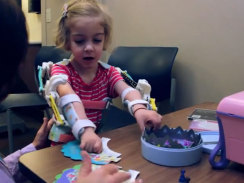Additive Manufacturing Gives Four Year Old Back the Use of Her Arms
 We've known for some time that 3D printers may one day revolutionize the field of medicine by printing entire organs, removing the need for organ donors, but this is years from large-scale implementation. However, additive manufacturing may already be making a profound impact on the lives of those with disabilities, such as four year-old Emma Levelle.
We've known for some time that 3D printers may one day revolutionize the field of medicine by printing entire organs, removing the need for organ donors, but this is years from large-scale implementation. However, additive manufacturing may already be making a profound impact on the lives of those with disabilities, such as four year-old Emma Levelle.
Emma's condition, called Arthrogryposis, causes abnormal muscle development and stiff joints that prevent Emma from even lifting her arms. It wasn't until her mother enrolled her in treatment with Dr. Tariq Rahman, creator of a robotic exoskeleton called WREX, that there was hope that Emma could regain function of her arms. It worked. Within moments of slipping into the WREX, she lifted her hands for the first time to play with her toys.
However, the exoskeleton, sold by JAECO Orthopedics, was built with heavy, metal components that were too cumbersome for a 25-pound girl. The solution was to enlist a Dimension 3D printer using the same type of plastic that makes LEGOs, to create a lightweight, durable exoskeleton that Emma came to call her “magic arms.
Not only has additive manufacturing enabled the creation of a smaller, lightweight alternative to the traditional WREX, it also allows the immediate production of replacement parts on demand if any component of Emma's exoskeleton were to break.
After outgrowing her first pair, Emma is currently on her second pair of magic arms.
Full story at CBS News










